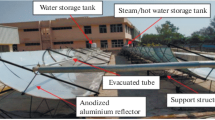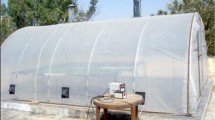Abstract
Open sun Crops drying is common in India even though a considerable time and dust accumulated. This is a serious issue. Workman ship and time reduction is needed to increase the productivity. Introduction of Green house solar dryer should be a right choice as against the conventional drying. The novel research focuses for retaining the nutritional values at higher level, very clean and with very less time for drying and supports the farmers at very affordable cost of drying. The four dryers are fabricated with two different roof materials and shapes. Each dryer bottom surface it is staked with three layers namely, black painted plywood, black PVC sheet of 3 mm thickness and stainless steel wire mesh tray. The results were noticed that moisture in the green peas is reduced from 76% to almost 9% in all dryers. The parabolic poly ethylene greenhouse solar dryer took 20 solar hr., whereas OSD took 32 solar hrs, in turns the saving of drying time is 37.5% compared to OSD. Different thin layer models were studied to fit with experimental data. Among all the thin layer models, Midilli and Kucuk model with PPEGHSD had shown a better agreement than the other models for the green peas. The performance and nutrition analysis have been carried out to ensure the quality of the dried products. It is observed that all the nutrition element values in the PPEGHSD are higher than the all other dryers and is suggested for the successful food grains drying.












Similar content being viewed by others
Abbreviations
- CT:
-
Crop Temperature (°C).
- ESPEGHSD:
-
Even span polyethylene greenhouse solar dryer.
- ESPVCGHSD:
-
Even span polyvinylchloride greenhouse solar dryer.
- PPEGHSD:
-
Parabolic polyethylene greenhouse solar dryer.
- PPVCGHSD:
-
Parabolic polyvinylchloride greenhouse solar dryer.
- EHTC:
-
Evaporative heat transfer coefficient (W/m2K).
- X:
-
Characteristic length of the tray (m).
- Kv :
-
Thermal conductivity of air inside dryer (W/mK).
- hc :
-
Convective heat transfer coefficients (W/m2K).
- Qe :
-
Heat utilized to evaporate the moisture from product (W).
- Tp :
-
Product surface temperature (°C).
- Te :
-
Temperature of the air (°C).
- P(Tp):
-
Partial vapor pressures (N/m2) at temperatures Tp.
- P(Te):
-
Partial vapor pressures (N/m2) at temperature Te.
- γ:
-
Relative humidity inside dryer (%).
- OSD:
-
Open sun drying.
- MR:
-
Moisture ratio.
- RMSE:
-
Root Mean Square Error.
- Χ2 :
-
Reduced chi square.
- r2 :
-
Correlation coefficient.
- φ:
-
Drying rate.
- A i :
-
Base area of the dryer (m2).
- I i :
-
Average solar radiation incident during drying (W/m2).
- E:
-
Energy (kJ).
- m:
-
Mass of the sample (g).
- N:
-
No of observations.
- n:
-
No of constants.
- a:
-
Ambient.
- evap :
-
Evaporation.
- exp,i :
-
i th experimentally.
- f :
-
Final.
- i :
-
Initial.
- in:
-
Input.
- int :
-
Instantaneous.
- o:
-
Atmosphere.
- r:
-
Greenhouse.
- pre,i :
-
i th predicted.
- sun:
-
solar radiation from sun.
- th :
-
Thermal.
References
Ayyappan S, Mayilsamy K, Sreenarayanan VV (2015) Performance improvement studies in a solar greenhouse drier using sensible heat storage materials. Heat Mass Transf 52(3):459–467. https://doi.org/10.1007/s00231-015-1568-5
Prakash O, Kumar A (2013) Performance evaluation of greenhouse dryer with opaque north wall. Heat Mass Transf 50(4):493–500. https://doi.org/10.1007/s00231-013-1256-2
Sahu TK, Gupta V, Singh AK (2016) A review on solar drying techniques and solar greenhouse dryer. IOSR J Mech Civil Eng 13(3):31–37. https://doi.org/10.9790/7388-1303033138
Condor M, Saravia L (2003) Analytical model for the performance of the tunnel-type greenhouse drier. Renew Energy 28(3):467–485. https://doi.org/10.1016/S0960-1481(01)00137-9
Kumar A, Tiwari GN (2006) Thermal modeling of a natural convection greenhouse drying system for jaggery: an experimental validation. Sol Energy 80(9):1135–1144. https://doi.org/10.1016/j.solener.2005.09.011
Lokeswaran S, Eswaramoorthy M (2013) Experimental studies on a solar drier system with a biomass back-up heater. Energy Source, Part A: Recover Util Environ Eff 35(5):467–475
Seveda M S (2012) Design and Development of Walk-In Type Hemi cylindrical Solar Tunnel Dryer for Industrial Use. ISRN Renewable Energy Volume 2012 Article ID 890820: 9 pages. https://doi.org/10.5402/2012/89082
Chauhan PS, Kumar A, Nuntadusit C, Banout J (2018) Thermal modeling and drying kinetics of bitter gourd flakes drying in modified greenhouse dryer. Renew Energy 118:799–813. https://doi.org/10.1016/j.renene.2017.11.069
Prakash O, Kumar A (2015) Annual performance of a modified greenhouse dryer under passive mode in no-load conditions. Int J Green Energy 12(11):1091–1099. https://doi.org/10.1080/15435075.2014.961461
Odesola IF, Ezekwem C (2012) The effect of shape and orientation on a greenhouse: a review. Int J Sci Technol 1(1):122–130
Purusothaman M, Valarmathi TN (2019) Computational fluid dynamics analysis of greenhouse solar dryer. Int J Ambient Energy 40(8):1–7. https://doi.org/10.1080/01430750.2018.1437567
Purusothaman M, Valarmathi T N, Sai SP (2019) CFD analysis of greenhouse solar dryer with different roof shapes, IEEE 408–412. https://doi.org/10.1109/ICONSTEM.2019.8918788
Sahdev RK, Kumar M, Dhingra AK (2019) A comprehensive review of greenhouse shapes and its applications. Front Energy 13(3):427–438. https://doi.org/10.1007/s11708-017-0464-8
Valarmathi TN, Sekar S, Purushothaman M, Sekar SD, Reddy MRS, Reddy KRNK (2017) Recent developments in drying of food products. IOP Conf Ser : Mater Sci Eng 197(1):1–10. https://doi.org/10.1088/1757-899X/197/1/012037
Perea-Moreno AJ, Juaidi A, Manzano-Agugliaro F (2016) Solar greenhouse dryer system for wood chips improvement as biofuel. J Clean Prod 135:1233–1241. https://doi.org/10.1016/j.jclepro.2016.07.036
Kumar M (2013) Forced convection greenhouse papad drying: an experimental study. J Eng Sci Technol 8(2):177–189
Kadam DM, Nangare DD, Singh R, Kumar S (2011) Low-cost greenhouse technology for drying onion (allium cepa l.) slices. J Food Process Eng 34(1):67–82. https://doi.org/10.1111/j.1745-4530.2008.00337.x
Rhoda AN, Simate IN (2016) Greenhouse solar drying and thin layer drying of fresh Kapenta. Int J Sci Eng Res 7(5):478–756. https://doi.org/10.13140/RG.2.2.11479.73121
Manjarekar RG, Mohod AG (2010) Experimental investigation of solar tunnel dryer for drying prawns. Int J Agric Eng 3(1):83–88
Janjai S, Chaichoet C, Intawee P (2005) Performance of a PV-ventilated greenhouse dryer for drying bananas. Asian J Energy Environ 6(02):133–139
Tiwari GN, Das T, Chen CR, Barnwal P (2009) Energy and exergy analyses of greenhouse fish drying. Int J Exergy 6(5):620–636. https://doi.org/10.1504/IJEX.2009.027493
Jain D (2006) Determination of convective heat and mass transfer coefficients for solar drying of fish. Biosyst Eng 94:429–435. https://doi.org/10.1016/j.biosystemseng.2006.04.006
Tellez MC, Figueroa IP, Vidana ECL, Martinez OS, Galvez GH (2017) Dehydration of the red chilli using an indirect-type forced convection solar dryer. Appl Therm Eng 114:1137–1144. https://doi.org/10.1016/j.applthermaleng.2016.08.114
Poonam Ekka J, Palanisamy M (2020) Determination of heat transfer coefficients and drying kinetics of red Chilli dried in a forced convection mixed mode solar dryer. Therm Sci Eng Progress https://doi.org/10.1016/j.tsep.2020.100607
Karthikeyan AK, Murugavelh S (2018) Thin layer drying kinetics and exergy analysis of turmeric in a mixed mode forced convection solar tunnel dryer. Renew Energy 128:305–312. https://doi.org/10.1016/j.renene.2018.05.061
Chauhan PS, Kumar A (2016) Performance analysis of greenhouse dryer by using insulated north-wall under natural convection mode. Energy Rep 2:107–116. https://doi.org/10.1016/j.egyr.2016.05.004
Tiwari S, Tiwari GN (2017) Grapes drying by semitransparent photovoltaic module integrated solar dryer: an experimental study. Heat Mass Transf 54(6):1637–1651. https://doi.org/10.1007/s00231-017-2257-3
Funding
The authors did not receive any grants from any of the agencies for carrying out the research work.
Author information
Authors and Affiliations
Contributions
Purusothaman M is a Research scholar in the School of Mechanical Engineering, Sathyabama Institute of Science and Technology. His area of interest includes greenhouse solar dryer, IC engines, Refrigeration and Air conditioning.
Dr.Valarmathi T.N is an Associate professor in School of Mechanical Engineering, Sathyabama Institute of Science and Technology. She is the specialist in Composites and Drying of food grains.
Corresponding author
Ethics declarations
Data availability
All data used during the study, appear in the submitted article.
Conflict of interest
The authors declare no conflicts of interest on research, authorship and publication.
Additional information
Publisher’s note
Springer Nature remains neutral with regard to jurisdictional claims in published maps and institutional affiliations.
Rights and permissions
About this article
Cite this article
Mani, P., Natesan, V.T. Thin layer modelling and thermal performance of active mode modified greenhouse solar dryers. Heat Mass Transfer 57, 1305–1318 (2021). https://doi.org/10.1007/s00231-021-03034-9
Received:
Accepted:
Published:
Issue Date:
DOI: https://doi.org/10.1007/s00231-021-03034-9




